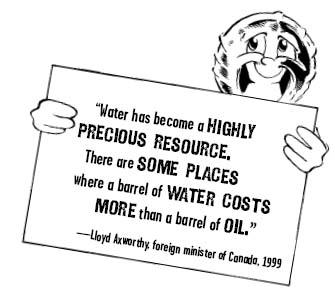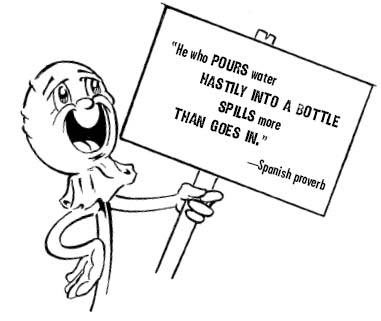When All Hell Breaks Loose (34 page)
Read When All Hell Breaks Loose Online
Authors: Cody Lundin

Seventy-five percent of a chicken is water.
Ninety-five percent of a tomato is water.
Seventy percent of an elephant is water.
Whatever containers you choose to store your water in, make sure they have tight-fitting lids to keep out debris and critters. Massive plastic water tanks, for example, have a few openings that are completely sealable and a manhole-type cover that has a one-way vent, thereby allowing the tank to "breathe" and compensate for air pressure changes. If your containers, both large and small, are not sealable, you will have all sorts of thirsty critters try to horn in on your supply, especially if you live in an arid environment.

I collect rain, and one of my catchment basins is a plastic fifty-five-gallon drum that's open to the air. Along with rain, it commonly collects rat poop, bird droppings, and other weirdness, but I don't care as it's reserved for watering specific vegetation. Some of the more heinous things it collects, especially during the hotter months, are swarms of bees looking for a drink. While we get along fine so far, they could be a problem around small children.
Warning!
It is not uncommon for bees to fly into open drinking containers of water. If your container is opaque, you will not see the bee when you take a drink. The bee could sting you in your mouth or throat and possibly cause a potentially fatal allergic reaction called
anaphylactic shock
. If your airway becomes occluded due to swelling caused by the sting, and you don't have immediate access to medical intervention, you will die. This scenario is especially common with opened soft drinks, as bees love sugary water. Deaths due to bee, wasp, and yellow jacket stings kill hundreds of people each year in the United States alone, so pay attention and consider using only transparent containers for drinking.
How Much Water Should I Store?
How much water you store depends on the variables already discussed and your opinion. At the bare minimum,
store at least one gallon per person per day
. If you live in an arid climate store as much water as you can, at least
three gallons per person per day
. The primary motive for storing and using this water is your family's hydration (thermoregulation), with cooking and sanitation close behind. Don't forget that pets will also require water. Rural and suburban families that own livestock, horses, or other large animals should plan accordingly for their needs. Most animal owners will know how much their animals drink during hot and cool weather—if not, pay attention the next time you water them.
Keep internally hydrated, but otherwise use water sparingly, and strictly ration your water with regard to sponge baths and the like. While most conventional emergency preparation information advises you to be independent and prepared for three days or seventy-two hours, be independent with water for at least one week, two weeks if possible, and three or four if you can manage the space and expense. Having "just enough" of any life-giving, precious resource leaves zero room for the variables that will happen after a disaster that will impact your stored supply. Never put all of your eggs in one basket and have, at minimum, two places in which you store your family's emergency water. These locations should be out of the sun and cool, if possible—away from toxic chemicals, gas containers, and other garage or closet household items that could permeate through some water containers and affect the quality of the water. Water should also be stored at your place of work and in each vehicle.
Water is fairly heavy, 8.3 pounds per gallon, and is not compressible, so the space that it takes up is the space that it takes up. Since water is so heavy, containing large amounts requires very well-made containers. There are many different containers available and all of them have their pros and cons. Before storing water in smaller preused containers, wash them first with dish detergent. After rinsing, disinfect the inside of the container with one teaspoon of household chlorine bleach per quart of water. Swish the mixture around and let it sit for a few minutes, rinse well, and you're ready to use it for water storage. Look at the following list of the most common water storage containers, and decide which containers or combinations of containers work for you.
Common Types of Water Storage Containers
Plastic
There are many advantages to using plastic containers. They are extremely common and they come in a large variety of sizes and shapes, from one-quart, backpacking-style water containers to massive tanks capable of holding thousands of gallons. They are durable, corrosion resistant, repairable, lightweight when empty, and relatively cheap. Opaque models will inhibit algae growth and come in nonattention-grabbing colors such as forest green and black.
Some disadvantages are that plastic will eventually deteriorate from ultraviolet rays from the sun, may burn/melt with sufficient heat, and will easily absorb and retain odors. Naysayers claim that all plastics eventually leach harmful chemicals into stored water.
Small Plastic Containers
There are many small plastic containers to choose from and all give you the option of easily transporting water. Due to their smaller size, usually under a gallon, they double as a convenient drinking container suitable for young children and older people alike. For long-term storage, look for containers that are made specifically for potable water or other liquids. This doesn't mean you should use a plastic container that housed paint thinner in its last life for even short-term use, so please, use common sense.
Liter Pop Bottles
These containers are tougher than hell, commonly available, easy to drink from for small children and the elderly, and store easily. I've had clients use them on rough, cross-country survival courses, and I'll admit, they can take some abuse. Almost all lack any useful opacity so they will breed algae if exposed to light for any length of time. This same trait makes them wonderful containers to use with the ultraviolet radiation "SODIS" water treatment method explained later in this chapter.
"Camping Style," One-Quart/Liter-Capacity Water Bottles
Your local camping and backpacking store will have a varied array of
quality, one-quart/liter-capacity water bottles
that can take extreme abuse. A common make is Nalgene. I wrap each Nalgene with two rows of duct tape that support a parachute cord loop with which I use to carry the bottle. The duct tape is supremely multiuse and has served me well for many tasks, from preventing blisters on feet and repairing rain gear to anchoring a splint made from a willow branch for a shattered patella. Six years ago, one of my Lexan plastic Nalgenes was run over by a truck hours before a film shoot with an Ohio news station (it's a long story). Other than a few abrasions, it's fine and I use it to this day. The older-style plastic Nalgenes, usually whitish in color, will degrade over time. I have had this type of plastic bottle shatter like glass when dropped. The weak link with Nalgene bottles is the plastic cap, as it's made from a softer plastic in order to grip and seal the container. I have had these caps shatter when my bottle was dropped. You can buy caps alone, they're about two dollars, and the wise person will pick up at least an extra cap per bottle.
Zipper-lock Freezer Baggies
I love zipper-lock freezer bags. Buy a name brand as there is a difference in quality and make sure to purchase "freezer" bags as they're thicker than standard zipper locks. Quality quart- and gallon-size freezer bags will hold their quantity in water, sealed in a standing position, without bursting open. As the quart-sized bag holds a quart and the gallon-sized bag holds a gallon of water, zipper-locks work well when using halogens such as iodine or chlorine to disinfect water. These bags have a very wide, flat mouth and can skim water from ground areas such as shallow puddles that other containers can't. They can also be scrunched up and reopened inside water-bearing areas to collect liquid that a quart bottle won't fit into. They are the everyday, urban version of the ultimate collapsible water container and have zillions of uses. Emergency zipper-lock water containers can be beefed up with duct tape on the outside to improve their durability against abrasions and punctures. Freezer bags also show promise when used as a container to disinfect water by ultraviolet radiation.

Juice Bottles
Plastic or glass juice bottles should be thoroughly washed and dried before use. However, even after multiple washings, you may smell and taste a hint of papaya or whatever type of juice the container originally held—the plastic containers will retain the smell and taste the most.
Bleach Bottles
